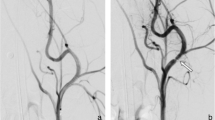Abstract
This study evaluated the mechanical properties and the surface elemental composition of Yasargil Phynox aneurysm clips implanted for 10 years in a patient with cerebral aneurysm. Two Yasargil Phynox aneurysm clips implanted 10 years previously to treat a ruptured vertebral artery aneurysm were retrieved when the regrown and ruptured aneurysm was repaired with a new aneurysm clip. Two new Yasargil aneurysm clips were used as controls. Measurements of closing force, bending strength, and the elemental composition of the clip surface were performed. The closing force of the retrieved clips was similar or greater compared to the force before implantation. The bending test showed that the elastic limit and 0.2% proof load of the retrieved clip were higher than those of the unused clip, whereas the ultimate load of the retrieved clip was similar to that of the unused clip. The elemental concentration of Cr oxide on the surface of the retrieved clips was almost the same as that on the unused clips. The present study demonstrated that Yasargil Phynox aneurysm clips retain their mechanical properties and surface elemental composition in vivo for a long time, which indicates that Yasargil aneurysm clips will remain reliable in patients for extended periods.




Similar content being viewed by others
References
Dujovny M, Wackenhut N, Kossovsky N, Gomes CW, Laha RK, Leff L, Nelson D (1979) Minimum vascular occlusive force. J Neurosurg 51:662–668
Hanawa T, Hiromoto S, Asami K (2001) Characterization of the surface oxide film of a Co-Cr-Mo alloy after being located in quasi-biological environments using XPS. Appl Surf Sci 183:68–75
International Organization for Standardization Technical Committee (2002) International Standard ISO 5832-7 In: Implants for surgery—metallic materials—Part 7: forgeable and cold-formed cobalt–chromium–nickel–molybdenum–iron alloy (designation 5832-7). International Organization for Standardization, Geneva
Jacobs JJ, Gilbert JL, Urban RM (1980) Corrosion of metal orthopaedic implants. J Bone Joint Surg Am 80:268–282
Kocijan A, Milosev I, Pihlar B (2004) Cobalt-based alloys for orthopaedic applications studied by electrochemical and XPS analysis. J Mater Sci Mater Med 15:643–650
Otawara Y, Endo MM, Ogasawara K, Kubo Y, Ogawa A, Watanabe K (2006) Reliability of cobalt-chromium alloy aneurysm clips after long-term implantations in patients with cerebral aneurysms. J Neurosurg 105:713–716
Author information
Authors and Affiliations
Corresponding author
Additional information
Comments
Maximilian Mehdorn, Kiel, Germany
This is a nice study dealing with a question that most neurosurgeons would have difficulties to answer but would like to have answered: what happens with the aneurysm clips which are in place for many years. Older neurosurgeons still remember when clips have slid from the aneurysm many years after what had been thought correct placement, and there had been some reports when clips of different materials had been used acting a dipoles of a battery and causing hydrolysis of the spring. Otawara and his colleagues are to be congratulated for their well thought-of analysis of 2 Yasargil Phynox clips that had been in place for 10 years. They could reassure the neurosurgical community that the 2 Yasargil clips had the same mechanical properties as a virgin clip prior to implantation, which the same group had previously already shown to be the case in Sugita aneurysm cips.
Beyond the scope of this presentation obviously is the question what happens to the aneurysmal wall over ten years. There seems to be only one old study (2) concerning these alterations. Why do aneurysms regrow and rupture at rates ranging from slightly below 1% for previously unruptured aneurysm during a followup of close to 9 years (3) up to 1.5% at mean followup of 4.4 years (1) after clipping when the clips are so perfect as suggested in this paper? Is there a continuous imflammatory reaction causing further weakness of the adjacent vessel wall? As we all are aware of the tissue alterations ocurring after coil placement it would be interesting to analyse the tissue which had previously been the aneurysmal wall and the neck – if this would be surgically accessible for removal i.e. if it could be harvested during repair of the newly formed or regrown aneurysm.
References
1. David CA, Vishteh AG, Spetzler RF, Lemole M, Lawton MT, Partovi S. Late angiographic follow-up review of surgically treated aneurysms. J Neurosurg. 1999 Sep;91(3):396–401.
2. Ebina K, Iwabuchi T, Suzuki S Histological change in permanently clipped or ligated cerebral arterial wall. Part II: Autopsy cases of aneurysmal neck clipping. Acta Neurochir (Wien). 1982;66(1-2):23–42.
3. Tsutsumi K, Ueki K, Usui M, Kwak S, Kirino T. Risk of subarachnoid hemorrhage after surgical treatment of unruptured cerebral aneurysms. Stroke. 1999 Jun;30(6):1181–4.
Rights and permissions
About this article
Cite this article
Otawara, Y., Ogasawara, K., Kubo, Y. et al. Mechanical and surface properties of Yasargil Phynox aneurysm clips after long-term implantation in a patient with cerebral aneurysm. Neurosurg Rev 32, 193–197 (2009). https://doi.org/10.1007/s10143-008-0180-2
Received:
Revised:
Accepted:
Published:
Issue Date:
DOI: https://doi.org/10.1007/s10143-008-0180-2




